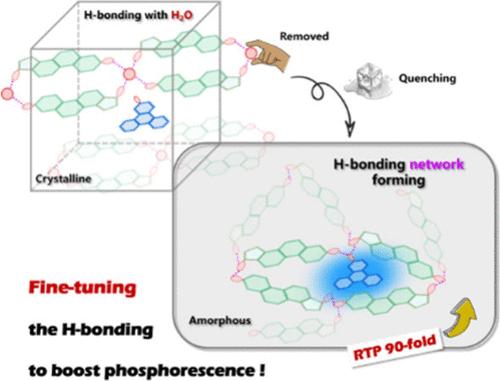氢键相互作用的微调对有机主客体系统室温磷光的促进作用
IF 4.6
2区 化学
Q2 CHEMISTRY, PHYSICAL
引用次数: 0
摘要
有机室温磷光(RTP)材料在光电子、防伪和生物医学等领域具有巨大的应用潜力。其中,主客体系统的 RTP 特性可以通过改变其组分参数来轻松调节,这引起了广泛关注。然而,宿主(晶体或非共价相互作用网络)在室温下增强磷光发射的关键因素仍不清楚。在这里,将雌二醇体系中的三苯基荧光粉加热以除去结晶水,然后冷却使其变成粉末。这使得余辉亮度提高了 90 多倍,磷光量子产率提高了 700 多倍。进一步的研究表明,在这些过程中,雌二醇的 -OH 基团的氢键相互作用发生了调整,从与结晶水键合到与客体键合,然后与客体构建了一个强大的网络。因此,三重激子得到了有效的稳定,再加上宿主合适的 T1 能级,可以显著增强无定形雌二醇体系的磷光效果。这项工作证明了掺杂雌二醇 RTP 系统内部氢键相互作用的微调可以增强其磷光。这项研究还证实,在主客体 RTP 体系中,非共价相互作用网络比晶体对高效磷光更重要。本文章由计算机程序翻译,如有差异,请以英文原文为准。

Fine Tuning of Hydrogen Bonding Interaction on Boosting the Room-Temperature Phosphorescence in Organic Host–Guest System
Organic room-temperature phosphorescence (RTP) materials have demonstrated great potential applications in optoelectronics, anticounterfeiting, and biomedicine fields. Among them, the RTP properties of host–guest systems can be easily regulated by changing their component parameters, which has attracted widespread attention. However, the key factor of the hosts (crystalline or noncovalent interaction network) for boosting phosphorescence emission at room temperature was still unclear. Herein, a triphenyl phosphor in the estradiol system was heated to remove the crystal water and then cooled to turn it into a powder. This enabled the afterglow brightness to improve by more than 90-fold and the phosphorescent quantum yield by over 700-fold. Further studies have indicated that the hydrogen bonding interactions of estradiol’s −OH group were tuned during these processes, from bonding with crystal water to bonding with guests and then constructing a strong network with the guests. The triplet excitons thus were effectively stabilized, which, coupled with the suitable T1 energy level of the host, could significantly enhance the phosphorescence in the amorphous estradiol system. This work demonstrates fine-tuning of the hydrogen bonding interactions inside the doped estradiol RTP system to boost its phosphorescence. It also substantiates that a noncovalent interaction network is more important than crystalline for efficient phosphorescence in a host–guest RTP system.
求助全文
通过发布文献求助,成功后即可免费获取论文全文。
去求助
来源期刊

The Journal of Physical Chemistry Letters
CHEMISTRY, PHYSICAL-NANOSCIENCE & NANOTECHNOLOGY
CiteScore
9.60
自引率
7.00%
发文量
1519
审稿时长
1.6 months
期刊介绍:
The Journal of Physical Chemistry (JPC) Letters is devoted to reporting new and original experimental and theoretical basic research of interest to physical chemists, biophysical chemists, chemical physicists, physicists, material scientists, and engineers. An important criterion for acceptance is that the paper reports a significant scientific advance and/or physical insight such that rapid publication is essential. Two issues of JPC Letters are published each month.
 求助内容:
求助内容: 应助结果提醒方式:
应助结果提醒方式:


